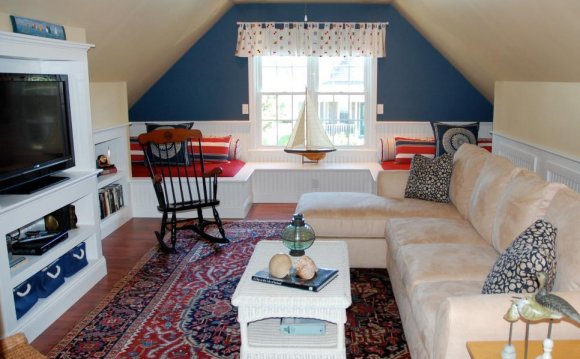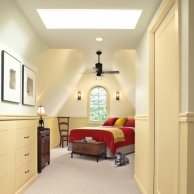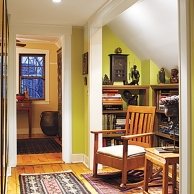
 Whether you envision your house's top floor as an away-from-it-all master suite, a quiet home office, or a hangout spot for the kids, don't lift a finger until you've read TOH's expert advice
Whether you envision your house's top floor as an away-from-it-all master suite, a quiet home office, or a hangout spot for the kids, don't lift a finger until you've read TOH's expert advice
2 ×
Account for Codes and Safety
Every attic is different, but a few established norms and practices will guide your renovation.
Follow the "rule of 7s": Enforcement varies, but codes typically say that at least half of a finished attic must be at least 7 feet high, and that this area must be a minimum of 7 feet wide and 70 square feet. A contractor or a local building official can help you assess how the rule will apply to your attic and how modifications like dormers can resolve height shortcomings.
Have a pro check the structure: A finished attic weighs a lot more than boxes of off-season duds. Hire an engineer to inspect your house's foundation and framing to ensure they can carry the extra load. At a minimum, you may need to strengthen the attic's floor joists, which are often too shallow or spaced too far apart for the job.
Assess your access: If you're building a stair-case from scratch, consider a switchback layout. It needs more room than a straight run (roughly 45 to 50 square feet per floor versus 33), but its footprint is more squarish than linear, so it will often fit in spaces where a straight run can't go. Just make sure the landing is large enough to maneuver furniture upstairs.
Just make sure the landing is large enough to maneuver furniture upstairs.
Pictured: A focal point at the top of an attic stairway, like this peaked bookshelf, draws people up.
3 ×
Ceiling Finish: "Wall" Frames
4 ×
Ceiling Finish: Beadboard Panels
A timeless classic, these tongue-and-groove panels are easy to install and will protect the low ceiling from dings and dents.
5 ×
 Ceiling Finish: V-groove Wood Paneling
Ceiling Finish: V-groove Wood Paneling
Photo by Bruce Hemming/IPC Images
Stained or left bare, wood makes a low-ceilinged attic feel snug and cozy. You can vary the look by using boards of different widths.
6 ×
Put in a Ceiling Fan for Better Climate Control
If you've got headroom, a fan will make a finished attic more comfortable in warmer months by giving you a cool breeze indoors. Flip the reverse switch in wintertime and it will push warmer air down to keep you cozy.
7 ×
 The Best Attic Lighting
The Best Attic Lighting
Photo by Alan Shortall/Cornerhouse Stock
Recessed LED fixtures tuck completely out of the way, don't generate unwanted heat, and can have insulation installed snugly, and safely, around them.
8 ×
Hush Up the Floors
Illustration by Eric Larsen
Attic activity can cause a racket in the rooms below. Beefier floor joists will quiet things down, as will filling the bays with blown-in dense-pack insulation. And don't forget the low-tech fix: carpet or area rugs.
9 ×
A Can't-Fail Color Scheme: All White
Photo by Robert Daly/Alamy
Painting walls, ceilings, floors, and even furnishings in a light hue ties together disparate materials, making even the tiniest attic feel larger and airier. Opt for warm whites, like ivory or cream, to avoid an antiseptic hospital look.
10 ×
Splurge on Spray-Foam Roof Insulation
Photo by Courtesy of Certainteed Corporation
It costs two to three times more than fiberglass batt insulation. But the roof is a major pathway to heat loss—and gain—so it's worth shelling out the extra bucks for spray foam. It forms a much tighter air barrier, and you'll get the same R-value with fewer inches of the stuff, so you'll have extra room overhead.













